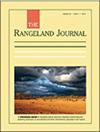金合欢叶叶落与营养成分的关系。澳大利亚中部的社区对降雨的反应
IF 0.9
4区 环境科学与生态学
Q4 ECOLOGY
引用次数: 1
摘要
金合欢叶叶的脱落。Benth交货。从1958年中期开始,在北领地爱丽丝泉以北的一个牲畜保护区的四个地点对澳大利亚中部的mulga进行了22个月的研究,以确定降雨或季节性诱因。在“成熟”mulga站点上,在15-20毫米或更多的降雨后的短时间内,叶状落叶的下降至少增加了一个数量级,在同一站点上的“年轻”和“沙漠形式”mulga以及第二个独立的“成熟”站点上,类似的趋势也很明显。当大量降雨后叶状叶的下降率很高时,在两个“成熟”地点,~30%的氮和~50%的磷在脱落前被带走,这表明mulga对这些营养物质明显保守。相反,在干燥条件下,当叶叶落量相对较低(<200 mg m−2 day−1)时,叶叶中氮和磷的浓度较高。钾、钙、镁和钠的浓度并没有随着叶状叶下降速率的增加而持续变化,尽管钙和钾的总体水平在第二个“成熟”位置要高得多。鉴于mulga群落对国家碳储量的贡献潜力,以及因此需要关于生长动态和碳通量的可靠的实地数据,这项遗留研究重新引起人们的兴趣。本文章由计算机程序翻译,如有差异,请以英文原文为准。
Phyllode fall and nutrient content in a mulga (Acacia aneura F.Muell. ex Benth.) community in central Australia in response to rainfall
The fall of phyllodes from Acacia aneura F.Muell. ex Benth. (mulga) in central Australia was studied over 22 months from mid-1958 at four locations within a livestock reserve north of Alice Springs in the Northern Territory, in order to identify rainfall or seasonal triggers. Phyllode fall increased by at least an order of magnitude for short periods following rain of 15–20 mm or more on a ‘mature’ mulga site and similar trends were apparent for ‘young’ and ‘desert form’ mulga on the same site, and on a second, independent, ‘mature’ site. When rates of phyllode fall were high after substantial rain, at both ‘mature’ locations, ~30% of nitrogen and ~50% of phosphorus were withdrawn before abscission, suggesting that mulga was markedly conservative of these nutrients. Conversely, under dry conditions, when phyllode fall was relatively low (<200 mg m−2 day−1), concentrations of nitrogen and phosphorus in fallen phyllodes were higher. Concentrations of potassium, calcium, magnesium and sodium did not vary consistently with increasing rate of phyllode fall, although overall levels of calcium and potassium were considerably higher in the second ‘mature’ location. This legacy study is of renewed interest given the potential of mulga communities to contribute to national carbon stocks, and the consequent need for robust field-based data on growth dynamics and carbon fluxes.
求助全文
通过发布文献求助,成功后即可免费获取论文全文。
去求助
来源期刊

Rangeland Journal
环境科学-生态学
CiteScore
2.90
自引率
8.30%
发文量
14
审稿时长
>36 weeks
期刊介绍:
The Rangeland Journal publishes original work that makes a significant contribution to understanding the biophysical, social, cultural, economic, and policy influences affecting rangeland use and management throughout the world. Rangelands are defined broadly and include all those environments where natural ecological processes predominate, and where values and benefits are based primarily on natural resources.
Articles may present the results of original research, contributions to theory or new conclusions reached from the review of a topic. Their structure need not conform to that of standard scientific articles but writing style must be clear and concise. All material presented must be well documented, critically analysed and objectively presented. All papers are peer-reviewed.
The Rangeland Journal is published on behalf of the Australian Rangeland Society.
 求助内容:
求助内容: 应助结果提醒方式:
应助结果提醒方式:


